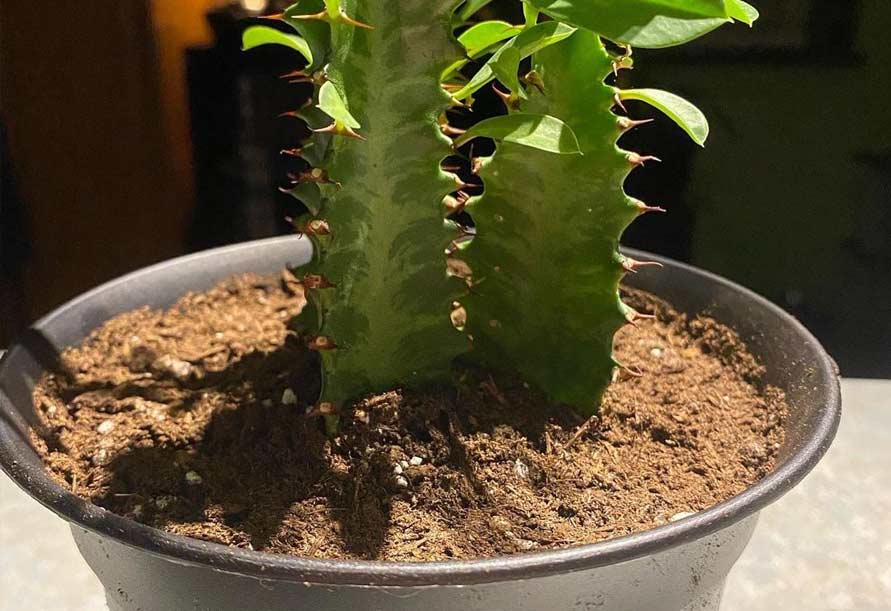
The African Milk tree with the scientific name Euphorbia trigona belongs to the Euphorbiaceae family. This plant is also known as the pencil tree; it is a shrub that grows well in semi-arid regions and tropical climates. The height of this plant typically reaches 3 meters and, in some areas, even up to 10 meters. Its appearance is stemmed without leaves and razor blades, smooth and without hairs. The exciting thing about this pencil plant is that among its stems are tiny flowers that bloom pale yellow. Euphorbia apartment plant is easy to maintain, and you can easily take care of this beautiful succulent at home or work. In this article, we want to make you more familiar with the storage conditions of the Euphorbia apartment plant. Please read on with Alo Plant.
| Jan | Feb | Mar | Apr | May | Jun | Jul | Aug | Sep | Oct | Nov | Dec | |
|---|---|---|---|---|---|---|---|---|---|---|---|---|
| Sowing | ||||||||||||
| Planting | ||||||||||||
| Harvesting |
| J | F | M | A | M | J | J | A | S | O | N | D | |
|---|---|---|---|---|---|---|---|---|---|---|---|---|
| Sowing | ||||||||||||
| Planting | ||||||||||||
| Harvesting |
| Botanical Name | Euphorbia trigona |
| Common Name | African milk tree, African milk bush |
| Plant Type | Succulent |
| Pet / Baby Safe | Toxic to humans and pets |
| Sun Exposure | Indirect sun to partial shade |
| Hardiness Zones | 10 to 12 |
| Bloom Time | Spring, summer |
| Soil Type | Leaf Soil, Medium rich, well-drained |
| Flower Color | White (outdoors only) |
| Foliage Color | Green |
| Plant Height | 72-96 in. |
| Native Area | Central Africa |
Introducing the African Milk tree

If you are interested in unique and different species of flowers and plants, you must have heard the name of this plant. Euphorbia trigona, commonly known as the cactus, is a member of the succulent family and, due to its appearance and storage conditions, is often confused with cacti. However, they are very different from each other. This plant is native to Central Africa and is mainly found in arid and desert areas. The stem of Euphorbia trigona is green, fleshy, and juicy and usually, three or four-sided, with shiny, teardrop-shaped leaves and thorns about 6 mm long growing on the edge of each triangular shape. The growth of this plant decreases in the cold seasons of the year, and its leaves also fall, which is a natural cycle of plant life, and there is no need to worry. Under favorable conditions, small greenish-yellow flowers grow on the edges of this plant, which are less known for their lack of exceptional beauty and are more popular because of the beautiful form of polygonal stems and leaves.
Watering conditions of African Milk tree at home

These plants are highly resistant to soil drought because they are carnivorous plants that need less irrigation. Water the Euphorbia once a week during the growing season (spring and summer) and keep it moist. Excessive watering of this plant will cause its roots to rot, so let the soil dry before re-watering the plant. Before watering, place your fingertips on the soil surface of the pot and check the moisture content.
What is the height of the African Milk tree at the time of growth?

Euphorbia is one of the largest flowering species that blooms in spring, and its flowers last until summer and fall asleep in winter. This cactus has a tall trunk that can be up to 2 meters high inside the apartment, but the height of this plant in nature and its birthplace reaches 12 meters.
The temperature required to maintain the African Milk tree
Species of the African Milk tree belonging to Saudi Arabia, western and central Africa, and the tropics of the United States need a temperature range of 13 to 15 degrees Celsius to survive the winter. Still, aphrodisiacs living in Madagascar and East Africa have temperatures. They also tolerate less than 13 to 10 degrees. Of course, species native to northern and southern Africa requires temperatures below 10 degrees.
The right time to change the African Milk tree pot

African Milk tree grows more than other plants of the succulent family, and as a result, due to the enlargement of its stems, we will have to change the pot. Annual replacement of this plant is unnecessary, and you can change the pot every two years. The ideal time to move the succulents is early spring when the growing season has begun. It is best to wait for one to two weeks before re-watering when moving your plants to a larger pot with new soil.
Soil suitable for planting African Milk tree

African Milk tree needs light soil with high drainage to grow. Try to use fine sand in the pot bed of this plant to provide the required drainage of this plant. To increase the growth rate of Euphorbia, you can also add a little leaf soil to the soil mixture.
Is the African Milk tree poisonous?
African Milk tree sap is a very toxic substance, and you should be careful not to touch it. This juice can cause severe irritation if it comes in contact with human skin. Eye contact can cause severe pain and sometimes even temporary blindness. If the plant is swallowed, it causes burning in the mouth and lips and may even cause suffocation. So if you have a child or pet in the house, be careful not to approach this plant or go to the care of safe plants.
Good light for African Milk tree

These plants need a lot of direct light, but they will grow well using artificial light. Gradually move the African Milk tree outdoors to enjoy the pleasant sunshine, as extreme light and temperature fluctuations are not suitable for the plant and will damage it.
Fertilizer suitable for planting African Milk tree
Although suitable for rooting, most soils can not provide all the essential elements needed by the plant. For this reason, it is necessary to use the right fertilizer. To do this, dissolve half a teaspoon of 15-15-15 multifunctional fertilizer in a liter of water and add it to the soil once every two weeks after watering. It should be done in spring and summer. Since the growth rate of Aphrodite cactus slows down in autumn and winter, you should stop fertilizing in these cold seasons.
The best way to propagate the African Milk tree

Although suitable for rooting, most soils can not provide all the essential elements needed by the plant. For this reason, it is necessary to use the right fertilizer. To do this, dissolve half a teaspTo propagate this plant, you must first select a part of the stem (7 to 10 cm) for the cuttings and separate it. When cutting the stem, make sure that your hand does not come into contact with the plant’s sap. Place the separated branch on a napkin. Place the stem in a place with average temperature and away from sunlight for a week to dry the plant wound. After this period, the prepared cuttings can be placed in a suitable cactus soil mixture with good drainage. You do not need to worry about the pH level of Euphorbia trigona soil. Keep the ground of the cut stem cuttings slightly moist after planting to allow the roots to form. You can then reduce the amount of irrigation.oon of 15-15-15 multifunctional fertilizer in a liter of water and add it to the soil once every two weeks after watering. It should be done in spring and summer. Since the growth rate of Aphrodite cactus slows down in autumn and winter, you should stop fertilizing in these cold seasons.
Familiarity with common diseases of the African Milk tree

1) Fungal infection
The presence of cork-like symptoms on the plant indicates that it has a fungal infection. This may be due to over-irrigation of the plant or excessive soil rich in minerals and nutrients. If you have other cuttings of the Aphorbia plant, killing the plant infected with the fungal infection is better. You can also cut the infected parts of the plant with a sterile knife, and after cutting, soak the cut areas in fungicide solution and keep the plant in a warm and pleasant place.
2) Scale insects
These tiny insects are covered with a brown, impenetrable shield, making them difficult to kill. Using paper towels soaked in alcohol or oil can help eliminate these pests.
3) Fusarium wilt
Fusarium wilt is another type of fungal infection caused by excessive soil moisture. Soft, red marks on the lower part of the stem indicate wilting of Fusarium, and the best course of action to combat the infection is to kill the plant.
Conclusion
African Milk tree belongs mostly to semi-arid and tropical climates and is a poisonous plant for pets and babies. The African Milk tree has been used as a houseplant in many countries! You can breed and propagate them by knowing their maintenance systems, such as suitable ambient temperature, soil conditions, and suitable distances for irrigation. We wanted to give you a reasonably comprehensive overview of maintaining an African Milk tree in this article. If you have any questions or concerns about this issue, please contact us in the comments section.
RELATED POSTS













